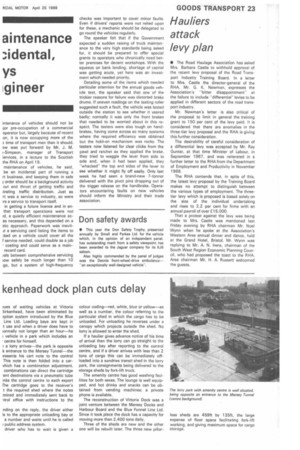aintenance
Page 25

If you've noticed an error in this article please click here to report it so we can fix it.
vs
igineer
intenance of vehicles should not be ijor pre-occupation of a commercial operator but, largely because of recent on, it is now occupying more of the a time of transport men than it should. aw was put forward by Mr. J. M. i-Simpson, manager of Transport lervices, in a lecture to the Scottish the RHA on April 19.
maintenance of vehicles, he said, be an incidental part of running a rt business, and keeping them in safe I order should be a background activity Cut and thrust of getting traffic and ,trating traffic distribution. Just as rt was a service to industry, so were irs a service to transport itself.
in getting a future licence and in enthat transport operations were not id, a quietly efficient maintenance aces necessary, and this depended on a ltic approach. Paperwork was inevittt a servicing card listing the items to ked on a vehicle could cover all the I service needed, could double as a job costing and could serve as a mainrecord card.
/els between comprehensive servicing low safely be much longer than 10 go, but a system of high-frequency checks was important to cover minor faults. Even if drivers' reports were not relied upon for these, a mechanic should be delegated to go round the vehicles regularly.
The speaker felt that if the Government expected a sudden raising of truck maintenance to the very high standards being asked for, it should be prepared to offer special grants to operators who chronically need better premises for decent workshops. With the squeeze on bank lending, shortage of capital was getting acute, yet here was an investment which needed priority.
Detailing some of the items which needed particular attention for the annual goods vehicle test, the speaker said that one of the trickier reasons for failure was distorted brake drums, if uneven readings on the testing roller suggested such a fault, the vehicle was tested outside the station to see whether it veered badly; normally it was only the front brakes that needed to be worried about in this respect. The testers were also tough on handbrakes, having come across so many systems where the required efficiency was obtained but the hold-on mechanism was rocky. The testers now listened for clear clicks from the pawl and ratchet as they applied the brake, they tried to waggle the lever from side to side and, when it had been applied, they "whacked" the top and sides of the lever to see whether it might fly off easily. Only last week he had seen a brand-new 7-tonner delivered with the pivot pins dropping out of the trigger release on the handbrake. Operators encountering faults on new vehicles should inform the Ministry and their trade association.
























































































































